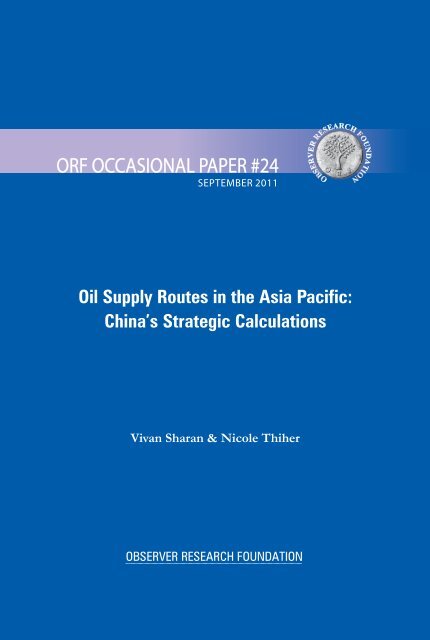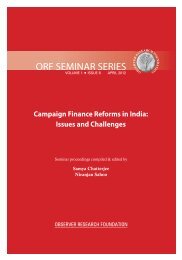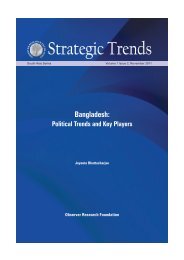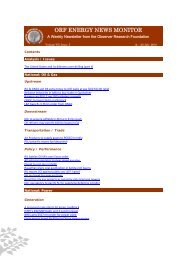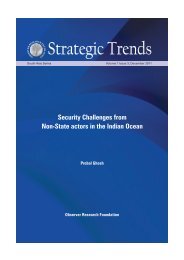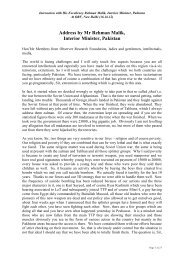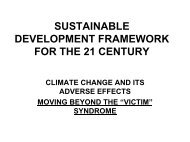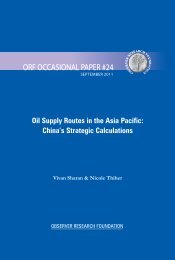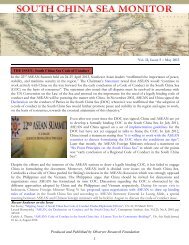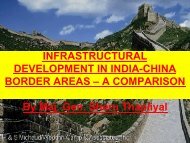Oil Supply Routes in the Asia Pacific: China's Strategic Calculations
Oil Supply Routes in the Asia Pacific: China's Strategic Calculations
Oil Supply Routes in the Asia Pacific: China's Strategic Calculations
You also want an ePaper? Increase the reach of your titles
YUMPU automatically turns print PDFs into web optimized ePapers that Google loves.
ORF OCCASIONAL PAPER #24<br />
SEPTEMBER 2011<br />
OBSERVER RESEARCH FOUNDATION<br />
<strong>Oil</strong> <strong>Supply</strong> <strong>Routes</strong> <strong>in</strong> <strong>the</strong> <strong>Asia</strong> <strong>Pacific</strong>:<br />
Ch<strong>in</strong>a’s <strong>Strategic</strong> <strong>Calculations</strong><br />
Vivan Sharan & Nicole Thiher<br />
OBSERVER RESEARCH FOUNDATION
<strong>Oil</strong> <strong>Supply</strong> <strong>Routes</strong> <strong>in</strong> <strong>the</strong> <strong>Asia</strong> <strong>Pacific</strong>:<br />
Ch<strong>in</strong>a’s <strong>Strategic</strong> <strong>Calculations</strong><br />
Vivan Sharan & Nicole Thiher<br />
OBSERVER RESEARCH FOUNDATION<br />
NEW DELHI
About <strong>the</strong> Authors<br />
Vivan Sharan is an Associate Fellow at <strong>the</strong> Observer Research<br />
Foundation, New Delhi. An experienced futures trader, his primary area of<br />
<strong>in</strong>terest is <strong>the</strong> global f<strong>in</strong>ancial markets,with particular focus on equity and<br />
commodity markets.<br />
Nicole Thiher is a graduate student at <strong>the</strong> University of Wiscons<strong>in</strong>,<br />
Madison and is currently work<strong>in</strong>g towards a Masters <strong>in</strong> International Public<br />
Affairs. This paper was written while she was a research <strong>in</strong>tern at <strong>the</strong><br />
Observer Research Foundation, New Delhi.<br />
2011 Observer Research Foundation. All rights reserved. No part of this publication may be<br />
reproduced or transmitted <strong>in</strong> any form or by any means without permission <strong>in</strong> writ<strong>in</strong>g from ORF.
<strong>Oil</strong> <strong>Supply</strong> <strong>Routes</strong> <strong>in</strong> <strong>the</strong> <strong>Asia</strong> <strong>Pacific</strong>:<br />
Ch<strong>in</strong>a’s <strong>Strategic</strong> <strong>Calculations</strong><br />
Abstract<br />
The purpose of this paper is to re-exam<strong>in</strong>e <strong>the</strong> exist<strong>in</strong>g critiques of Ch<strong>in</strong>a's oil<br />
supply diversification strategies <strong>in</strong> <strong>the</strong> <strong>Asia</strong> <strong>Pacific</strong>. It deconstructs <strong>the</strong> grow<strong>in</strong>g<br />
energy relationship between Ch<strong>in</strong>a and <strong>the</strong> Middle East that has made <strong>the</strong><br />
security of <strong>the</strong> Hormuz Strait and <strong>the</strong> Malacca Strait vital to Ch<strong>in</strong>a's energy<br />
security. It analyses specific geographic and strategic chokepo<strong>in</strong>ts <strong>in</strong> Ch<strong>in</strong>a's oil<br />
supply route and concludes that supply diversification motivations are driven by<br />
<strong>the</strong> nation's political economy and military strategy.<br />
Introduction<br />
Energy security forms <strong>the</strong> backbone of most economic and political<br />
policies of nations around <strong>the</strong> world. Ch<strong>in</strong>a is no exception and is<br />
<strong>in</strong>creas<strong>in</strong>gly follow<strong>in</strong>g a multi-pronged global strategy—one where its<br />
economic priorities do not necessarily overlap with its foreign policies. This<br />
has enabled Ch<strong>in</strong>a to <strong>in</strong>terface with a wide range of nations and bus<strong>in</strong>esses<br />
to secure its <strong>in</strong>terests <strong>in</strong> energy all around <strong>the</strong> world, particularly <strong>in</strong> oil.<br />
In 1993, Ch<strong>in</strong>a went from be<strong>in</strong>g a net exporter of oil to a net importer.<br />
Accord<strong>in</strong>g to <strong>the</strong> National Development and Reform Commission, Ch<strong>in</strong>a's<br />
1<br />
energy consumption <strong>in</strong>creased by 5.6% annually from 1980-2006 . It is <strong>the</strong><br />
second largest consumer of oil after <strong>the</strong> United States and is set to overtake<br />
it with<strong>in</strong> a decade. Today oil rema<strong>in</strong>s a resource without many practical<br />
substitutes for many of its end uses. Figure 1 shows <strong>the</strong> exponential growth<br />
<strong>in</strong> <strong>the</strong> consumption of oil <strong>in</strong> Ch<strong>in</strong>a, while oil production rema<strong>in</strong>s almost<br />
stagnant. This has left a big supply gap which is addressed through <strong>in</strong>creased<br />
imports–emphasis<strong>in</strong>g <strong>the</strong> need for <strong>the</strong> country to ensure secure and<br />
efficient supply channels.<br />
www.orfonl<strong>in</strong>e.org 1
ORF Occasional Paper<br />
Figure 1<br />
Ch<strong>in</strong>ese <strong>Oil</strong> Trends<br />
Source: U.S. Energy Information Adm<strong>in</strong>istration<br />
In 2008, Ch<strong>in</strong>a established <strong>the</strong> National Energy Adm<strong>in</strong>istration with<strong>in</strong> <strong>the</strong><br />
National Development and Reform Commission to streng<strong>the</strong>n its ability to<br />
manage <strong>the</strong> energy sector and handle energy issues both at home and<br />
abroad. Ch<strong>in</strong>a's oil production capabilities are extensive. The Ch<strong>in</strong>a<br />
National Petroleum Corporation (CNPC) is <strong>the</strong> fourth largest national oil<br />
corporation <strong>in</strong> <strong>the</strong> world <strong>in</strong> terms of oil reserves and <strong>the</strong> largest <strong>in</strong> <strong>the</strong><br />
country. The Ch<strong>in</strong>a Petrochemical Corporation (S<strong>in</strong>opec) is <strong>the</strong> second<br />
largest <strong>in</strong> Ch<strong>in</strong>a and <strong>the</strong> Ch<strong>in</strong>a National Offshore <strong>Oil</strong> Corporation<br />
(CNOOC) is <strong>the</strong> third largest. These three state-owned corporations<br />
account for 95% of <strong>the</strong> crude oil produced <strong>in</strong> Ch<strong>in</strong>a. They have also become<br />
<strong>in</strong>creas<strong>in</strong>gly active <strong>in</strong> oil trade and <strong>in</strong>vestment all over <strong>the</strong> world, particularly<br />
<strong>in</strong> Africa and Central <strong>Asia</strong>.<br />
Ch<strong>in</strong>a depends on oil imports to meet over half of its domestic demand.<br />
Over 80% of <strong>the</strong>se imports are transported by oil tankers. Approximately<br />
half of Ch<strong>in</strong>a's oil imports come from <strong>the</strong> Persian Gulf via <strong>the</strong> sea, and <strong>the</strong><br />
2<br />
www.orfonl<strong>in</strong>e.org
<strong>Oil</strong> <strong>Supply</strong> <strong>Routes</strong> <strong>in</strong> <strong>the</strong> <strong>Asia</strong> <strong>Pacific</strong>: Ch<strong>in</strong>a’s <strong>Strategic</strong> <strong>Calculations</strong><br />
bulk of <strong>the</strong>se imports pass through <strong>the</strong> Hormuz Strait, ly<strong>in</strong>g <strong>in</strong> <strong>the</strong> waters<br />
between <strong>the</strong> Arabian Pen<strong>in</strong>sula and Iran. The Hormuz Strait and <strong>the</strong><br />
Malacca Strait are two narrow sea lanes that are used by <strong>the</strong> majority of <strong>the</strong><br />
tankers (s<strong>in</strong>ce this is <strong>the</strong> shortest navigable route), carry<strong>in</strong>g oil from <strong>the</strong> oil<br />
rich Persian Gulf to <strong>the</strong> eastern ports of Ch<strong>in</strong>a (figure 2).<br />
Figure 2: Shipp<strong>in</strong>g <strong>Routes</strong> for Ch<strong>in</strong>ese <strong>Oil</strong> Tankers<br />
Source: Harvard <strong>Asia</strong> Quarterly<br />
In this paper, we will focus on Ch<strong>in</strong>a's hedg<strong>in</strong>g strategies along <strong>the</strong><br />
2<br />
'chokepo<strong>in</strong>ts' on <strong>the</strong> aforementioned route . We also look at <strong>the</strong> alternative<br />
means of transport (pipel<strong>in</strong>es) and alternative routes, and present a<br />
quantitative assessment of <strong>the</strong> costs and benefits <strong>in</strong>volved for <strong>the</strong> country <strong>in</strong><br />
revert<strong>in</strong>g to <strong>the</strong> different options <strong>in</strong> case of supply disruptions at sea. In <strong>the</strong><br />
process, we evaluate whe<strong>the</strong>r <strong>the</strong> alternatives are f<strong>in</strong>ancially and strategically<br />
feasible and assess <strong>the</strong> viability of a truly diversified import supply.<br />
Ch<strong>in</strong>a is <strong>in</strong>deed over-dependent on its oil supply routes through <strong>the</strong> seas.<br />
The diversification strategies carried out so far have been far from cost<br />
effective, compared to <strong>the</strong> usual routes. Perhaps some of <strong>the</strong> present day<br />
www.orfonl<strong>in</strong>e.org 3
ORF Occasional Paper<br />
rhetoric generated <strong>in</strong> Ch<strong>in</strong>ese policy mak<strong>in</strong>g circles about supply security<br />
imperatives <strong>in</strong> <strong>the</strong> <strong>Asia</strong> <strong>Pacific</strong> is deliberately distorted.<br />
A Note about <strong>Oil</strong> Tankers<br />
Crude oil tankers are primarily divided <strong>in</strong>to five classes as shown <strong>in</strong> <strong>the</strong> table<br />
below. Rang<strong>in</strong>g from <strong>the</strong> Panamax–which is <strong>the</strong> smallest class and is able to<br />
go through <strong>the</strong> Panama Canal, to <strong>the</strong> Ultra Large Crude Carrier, which is<br />
only able to go through wide and deep stretches <strong>in</strong> <strong>the</strong> sea. Ultra Large and<br />
Very Large Crude Carriers (VLCC) are also called “supertankers” ow<strong>in</strong>g to<br />
<strong>the</strong>ir behemoth size and capacities. In this paper, we use VLCC to<br />
benchmark oil transport through <strong>the</strong> seas; <strong>the</strong>y carry 2 million barrels of oil<br />
per day (bpd) and are able to go through both <strong>the</strong> Hormuz and Malacca<br />
3<br />
Straits.<br />
Categories and Specifications of oil Tankers<br />
Tanker Class Deadweight Tons Barrels of <strong>Oil</strong><br />
Panamax 60,000- 80,000 500,000<br />
Aframax 80,000- 120,000 750,000<br />
Suezmax 120,000- 200,000 1,000,000<br />
Very Large Crude Carrier (VLCC) 200,000- 320,000 2,000,000<br />
Ultra Large Crude Carrier (ULCC) 320,000 + up to 4,000,000<br />
Source: <strong>Pacific</strong> L.A. Mar<strong>in</strong>e Term<strong>in</strong>al LLC<br />
<strong>Strategic</strong> Reserves<br />
<strong>Strategic</strong> oil reserves are a valuable hedge that oil import<strong>in</strong>g nations can use<br />
to try and protect <strong>the</strong>mselves aga<strong>in</strong>st price volatility and temporary supply<br />
disruptions. In 2001, Ch<strong>in</strong>a developed plans to establish its own national<br />
strategic petroleum reserve <strong>in</strong> three phases with a target volume of 90 days<br />
of net imports. The first phase was completed <strong>in</strong> 2009. Four crude oil<br />
storage facilities with a comb<strong>in</strong>ed total capacity of 102 million barrels have<br />
4<br />
www.orfonl<strong>in</strong>e.org
<strong>Oil</strong> <strong>Supply</strong> <strong>Routes</strong> <strong>in</strong> <strong>the</strong> <strong>Asia</strong> <strong>Pacific</strong>: Ch<strong>in</strong>a’s <strong>Strategic</strong> <strong>Calculations</strong><br />
been set up. The second phase of <strong>the</strong> plan is well underway and is expected<br />
to be completed <strong>in</strong> 2012. This will br<strong>in</strong>g Ch<strong>in</strong>a's reserves up to 272 million<br />
barrels. By 2020 Ch<strong>in</strong>a plans to have added ano<strong>the</strong>r 204 million barrels to its<br />
strategic reserves; a total of 476 million barrels or approximately 123 days of<br />
reserves at 2009 import levels. At this level, Ch<strong>in</strong>a would have <strong>the</strong> largest<br />
strategic reserves of oil relative to <strong>the</strong> amount it imports <strong>in</strong> <strong>the</strong> world. As a<br />
result, Ch<strong>in</strong>a will be able to withstand relatively long term supply<br />
disruptions.<br />
Ch<strong>in</strong>ese <strong>Strategic</strong> <strong>Oil</strong> Reserves<br />
Site Completion Million Barrels Days of Net Imports at 2009 Levels<br />
First Phase:<br />
Zhenhai, Zhej<strong>in</strong>g 2006 32.7 8.4<br />
Dalian, Liaon<strong>in</strong>g 2008 18.9 4.9<br />
Huangdao, Shandong 2008 18.9 4.9<br />
Zhoushan, Zhejiang 2007 31.4 8.1<br />
Total 101.9 26.3<br />
Second Phase:<br />
8 Locations exp. 2012 170 43.8<br />
Total 271.9 70.1<br />
Third Phase:<br />
Undeterm<strong>in</strong>ed exp. 2020 204 52.6<br />
Total 475.9 122.7<br />
Source: Reuters<br />
Country<br />
<strong>Strategic</strong> <strong>Oil</strong> Reserves<br />
(millions of barrels)<br />
Global <strong>Strategic</strong> <strong>Oil</strong> Reserves<br />
Days of Net Imports<br />
at 2009 Levels<br />
Days of Consumption<br />
at 2009 Levels<br />
Ch<strong>in</strong>a (2012) 272 70.1 32.7<br />
Ch<strong>in</strong>a (2020) 476 122.7 57.2<br />
United States 727 80.7 38.7<br />
Japan 323 93.8 74.0<br />
Germany 184 93.2 74.9<br />
France 99 68.7 54.2<br />
South Korea 87 37.5 39.8<br />
Source: U.S. Energy Information Adm<strong>in</strong>istration<br />
www.orfonl<strong>in</strong>e.org 5
ORF Occasional Paper<br />
The Hormuz Game<br />
The Chokepo<strong>in</strong>t—The narrow Hormuz Strait connects <strong>the</strong> Gulf of<br />
Oman with <strong>the</strong> Persian Gulf. About 20% of <strong>the</strong> world's oil demand, 15<br />
million bpd, is supplied through ships that transit <strong>in</strong> and out of <strong>the</strong> strait,<br />
where navigation is limited to two 3 km wide channels. This restricted<br />
navigability and forced convergence of sea traffic flow<strong>in</strong>g through <strong>the</strong><br />
channels qualifies <strong>the</strong> strait as a geographic and strategic maritime<br />
chokepo<strong>in</strong>t.<br />
For Ch<strong>in</strong>a, <strong>the</strong> area is of great strategic significance. Its imports <strong>in</strong> 2010<br />
through <strong>the</strong> Strait reached 2.4 million bpd or 40% of its total imported oil.<br />
Although Ch<strong>in</strong>a's dependence on <strong>the</strong> region is lower than o<strong>the</strong>r high growth<br />
develop<strong>in</strong>g countries such as India, it is significantly greater than <strong>the</strong> US or<br />
Europe's degree of dependence. Overall, <strong>the</strong> Persian Gulf region is and will<br />
rema<strong>in</strong> one of <strong>the</strong> ma<strong>in</strong> sources of oil for Ch<strong>in</strong>a for decades to come (figure<br />
3). Given <strong>the</strong> size of reserves <strong>in</strong> <strong>the</strong> region, this dependence or vulnerability<br />
—depend<strong>in</strong>g on which way it is analysed—is unlikely to dim<strong>in</strong>ish greatly <strong>in</strong><br />
<strong>the</strong> future. S<strong>in</strong>ce many of <strong>the</strong> oil resources across <strong>the</strong> globe are projected to<br />
decrease steadily over <strong>the</strong> next few decades, <strong>the</strong> proven reserves <strong>in</strong> <strong>the</strong><br />
Middle East are go<strong>in</strong>g to rema<strong>in</strong> among <strong>the</strong> most sought after sources. The<br />
Gulf Research Centre has estimated that by 2030, one <strong>in</strong> every three barrels<br />
4<br />
of oil consumed <strong>in</strong> Ch<strong>in</strong>a will come from <strong>the</strong> region .<br />
Dependency on <strong>Oil</strong> Imports from <strong>the</strong> Middle East -2010<br />
M.E. Imports (m of bpd)<br />
M.E. Imports as a Percentage of Total Imports<br />
US 1.73 14.8%<br />
Europe 2.36 19.5%<br />
Ch<strong>in</strong>a 2.38 40.0%<br />
India 2.61 72.6%<br />
Source: BP Statistical Review of World Energy 2011<br />
The Suppliers: In 2010, <strong>the</strong> Middle East region accounted for over 54% of<br />
<strong>the</strong> world's total reserves with Saudi Arabia, Iran, Iraq, Kuwait and <strong>the</strong> UAE<br />
6<br />
www.orfonl<strong>in</strong>e.org
<strong>Oil</strong> <strong>Supply</strong> <strong>Routes</strong> <strong>in</strong> <strong>the</strong> <strong>Asia</strong> <strong>Pacific</strong>: Ch<strong>in</strong>a’s <strong>Strategic</strong> <strong>Calculations</strong><br />
respectively hav<strong>in</strong>g up <strong>the</strong> largest proportions (Qatar comes <strong>in</strong> a distant<br />
th<br />
6 —none<strong>the</strong>less it is strategically important because it is likely to be a major<br />
supplier of natural gas to Ch<strong>in</strong>a <strong>in</strong> <strong>the</strong> future). Consequently, <strong>the</strong>se are <strong>the</strong><br />
countries that are of long term importance to Ch<strong>in</strong>a <strong>in</strong> terms of its energy<br />
supply needs. Ch<strong>in</strong>a’s oil imports from <strong>the</strong>se major players have grown<br />
rapidly <strong>in</strong> <strong>the</strong> last two decades. It can be argued that supply arrangements<br />
with o<strong>the</strong>r countries <strong>in</strong> <strong>the</strong> region are likely to be short term engagements.<br />
Figure 3<br />
Percentage of Global <strong>Oil</strong> Reserves <strong>in</strong> <strong>the</strong><br />
Middle East <strong>in</strong> 2010<br />
United Arab<br />
Emirates,<br />
7.1%<br />
Iran, 9.9%<br />
Iraq, 8.3%<br />
Saudi Arabia,<br />
19.1%<br />
Qatar, 1.9%<br />
Kuwait, 7.3%<br />
Source: BP Statistical Review of World Energy 2011<br />
In 1999, Ch<strong>in</strong>ese President Jiang Zem<strong>in</strong> visited Saudi Arabia on a state visit<br />
and pronounced a “strategic oil partnership” between <strong>the</strong> two countries. In<br />
November 2010, Ch<strong>in</strong>a overtook <strong>the</strong> US as Saudi Arabia's biggest oil<br />
customer. It buys more than a million bpd from Saudi Arabia—constitut<strong>in</strong>g<br />
approximately a fifth of its total imports. Ch<strong>in</strong>a's total imports have doubled<br />
s<strong>in</strong>ce 2005; an <strong>in</strong>dication of <strong>the</strong> fast pace at which Ch<strong>in</strong>ese demand and<br />
bilateral ties are grow<strong>in</strong>g <strong>in</strong> what is today perhaps <strong>the</strong> world's most<br />
significant energy relationship. The relationship is enhanced by <strong>the</strong> fact that<br />
Ch<strong>in</strong>a has been grant<strong>in</strong>g many downstream projects to Saudi Aramco and<br />
Saudi Basic Industries Company <strong>in</strong> Ch<strong>in</strong>a, and <strong>the</strong>re are about 90 Ch<strong>in</strong>ese<br />
www.orfonl<strong>in</strong>e.org 7
ORF Occasional Paper<br />
5<br />
companies do<strong>in</strong>g bus<strong>in</strong>ess <strong>in</strong> Saudi Arabia . The Jubail K<strong>in</strong>g Fahd Ports, Ras<br />
Al Juaymah, Ras Tanura Term<strong>in</strong>al and Yanbu' Term<strong>in</strong>al are <strong>the</strong> major supply<br />
hubs <strong>in</strong> <strong>the</strong> country (see Appendix, table 1).<br />
The second largest proven oil reserves <strong>in</strong> <strong>the</strong> world are <strong>in</strong> Iran, and Ch<strong>in</strong>a is<br />
its biggest customer. Accord<strong>in</strong>g to IRNA (Iran's official news agency), <strong>the</strong><br />
country supplied over 62 million barrels of crude oil to Ch<strong>in</strong>a <strong>in</strong> <strong>the</strong> first<br />
6<br />
four months of 2011 . In turn, Ch<strong>in</strong>a has reported to have <strong>in</strong>vested about<br />
$40 billion <strong>in</strong> both upstream and downstream projects <strong>in</strong> Iran's oil and gas<br />
sector—tak<strong>in</strong>g advantage of Tehran's open <strong>in</strong>vitation to do so as a result of<br />
7<br />
Western sanctions . The countries have also expanded <strong>the</strong>ir overall trade<br />
relationship with bilateral trade amount<strong>in</strong>g to about $30 billion <strong>in</strong> 2010. Iran<br />
has three major offshore term<strong>in</strong>als <strong>in</strong> <strong>the</strong> Persian Gulf that can service<br />
tankers as large as ULCC class (see Appendix, table 2).<br />
Ch<strong>in</strong>a has been aggressive <strong>in</strong> pursu<strong>in</strong>g deals to develop Iraq's oil fields and<br />
has secured <strong>in</strong>terests <strong>in</strong> <strong>the</strong> Al-Ahdab oil field as well as service contracts for<br />
<strong>the</strong> Halfaya and Rumaila oil fields. Iraq exported about 144,000 bpd to<br />
Ch<strong>in</strong>a <strong>in</strong> 2009. Most of <strong>the</strong> oil exports to Ch<strong>in</strong>a leave <strong>the</strong> country by ship<br />
through <strong>the</strong> age<strong>in</strong>g Al-Basrah term<strong>in</strong>al, 30 miles off Iraq's sou<strong>the</strong>rn coast<br />
(See Appendix, table 3).<br />
Kuwait supplied close to 200,000 bpd of oil to Ch<strong>in</strong>a <strong>in</strong> 2010. The Kuwait<br />
Petroleum Corporation and S<strong>in</strong>opec are jo<strong>in</strong>tly collaborat<strong>in</strong>g on develop<strong>in</strong>g<br />
a $9 billion petrochemical complex <strong>in</strong> Ch<strong>in</strong>a's Guangdong prov<strong>in</strong>ce with<br />
construction scheduled to beg<strong>in</strong> next year. Follow<strong>in</strong>g clearances from<br />
Ch<strong>in</strong>a's National Development and Reform Commission, <strong>the</strong> Kuwait<br />
Petroleum Corporation is expect<strong>in</strong>g Ch<strong>in</strong>ese exports to grow to 500,000<br />
8<br />
bpd by 2015 . Most of <strong>the</strong> oil exports go through three term<strong>in</strong>als located <strong>in</strong><br />
<strong>the</strong> Persian Gulf—<strong>the</strong> M<strong>in</strong>a Ahamdi, M<strong>in</strong>a Abdullah and M<strong>in</strong>a Shuaiba<br />
term<strong>in</strong>als.<br />
8<br />
www.orfonl<strong>in</strong>e.org
<strong>Oil</strong> <strong>Supply</strong> <strong>Routes</strong> <strong>in</strong> <strong>the</strong> <strong>Asia</strong> <strong>Pacific</strong>: Ch<strong>in</strong>a’s <strong>Strategic</strong> <strong>Calculations</strong><br />
Ch<strong>in</strong>a imported about 100,000 bpd from UAE <strong>in</strong> 2010. The Capital, Abu<br />
Dhabi, exports <strong>the</strong> majority of <strong>the</strong> UAE crude oil from its term<strong>in</strong>als (a small<br />
proportion is also shipped from Dubai). CNPC and <strong>the</strong> Abu Dhabi<br />
National <strong>Oil</strong> Co. signed a 20-year oil supply deal <strong>in</strong> July 2011, whereby <strong>the</strong><br />
latter would export 200,000 bpd to Ch<strong>in</strong>a start<strong>in</strong>g <strong>in</strong> 2014.<br />
Def<strong>in</strong><strong>in</strong>g <strong>the</strong> Threat: In this paper, we def<strong>in</strong>e <strong>the</strong> real and perceived threat<br />
without def<strong>in</strong><strong>in</strong>g <strong>the</strong> stimuli or <strong>the</strong> actors. The threat of a blockade of <strong>the</strong><br />
Hormuz Strait or of a direct rogue attack on any of <strong>the</strong> major facilities<br />
located along <strong>the</strong> Gulf coastl<strong>in</strong>e would have rippl<strong>in</strong>g effects throughout <strong>the</strong><br />
global economy. The consequences of a disruption of supplies from <strong>the</strong><br />
area would impact on Ch<strong>in</strong>a only if <strong>the</strong> disruption is very long—last<strong>in</strong>g over<br />
a few weeks (global spot trad<strong>in</strong>g prices for oil would shoot up, but countries<br />
like Ch<strong>in</strong>a, with sufficient strategic reserves, would be able to release <strong>the</strong><br />
price pressures <strong>in</strong> <strong>the</strong> short term). It is also worth not<strong>in</strong>g that <strong>in</strong>surance<br />
9<br />
companies would not be ready to <strong>in</strong>sure Ch<strong>in</strong>ese ships <strong>in</strong> war conditions .<br />
The Hormuz Hedges: Hav<strong>in</strong>g effective diversification strategies and<br />
plans <strong>in</strong> <strong>the</strong> Middle East is very important to Ch<strong>in</strong>a. The Information Office<br />
of <strong>the</strong> State Council of Ch<strong>in</strong>a <strong>in</strong> its December 2007 report ma<strong>in</strong>ta<strong>in</strong>ed that,<br />
“The <strong>in</strong>ternational community should work collaboratively to ma<strong>in</strong>ta<strong>in</strong><br />
stability <strong>in</strong> oil produc<strong>in</strong>g and export<strong>in</strong>g countries, especially those <strong>in</strong> <strong>the</strong><br />
Middle East, to ensure <strong>the</strong> security of <strong>in</strong>ternational energy transport routes<br />
and avoid geopolitical conflicts that affect <strong>the</strong> world's energy supply”.<br />
There are many estimates for what <strong>the</strong> United States spends on its military <strong>in</strong><br />
<strong>the</strong> Gulf region to keep its oil <strong>in</strong>terests <strong>in</strong> <strong>the</strong> area safe—rang<strong>in</strong>g from $44<br />
10<br />
billion per year on <strong>the</strong> conservative side to $125 billion . On <strong>the</strong> o<strong>the</strong>r hand,<br />
11<br />
Ch<strong>in</strong>a spends very little on protect<strong>in</strong>g <strong>the</strong> region even through its relative<br />
dependency on oil from <strong>the</strong> Middle East is twice that of <strong>the</strong> US.<br />
www.orfonl<strong>in</strong>e.org 9
ORF Occasional Paper<br />
Ch<strong>in</strong>a <strong>in</strong>stead concentrates a significant amount of economic purchas<strong>in</strong>g<br />
power on oil supply diversification. This is carried out through collaborative<br />
development of oil <strong>in</strong>frastructure throughout <strong>the</strong> region (see appendix,<br />
table 4) and establish<strong>in</strong>g long term purchase contracts to hedge aga<strong>in</strong>st spot<br />
price volatility. Fur<strong>the</strong>r, <strong>in</strong> <strong>the</strong> event of a disruption, Ch<strong>in</strong>a and <strong>the</strong> rest of<br />
<strong>the</strong> countries around <strong>the</strong> world that are dependent on Persian Gulf oil<br />
imports would largely be dependent on <strong>the</strong> exist<strong>in</strong>g pipel<strong>in</strong>e <strong>in</strong>frastructure<br />
<strong>in</strong> <strong>the</strong> Middle East.<br />
Accord<strong>in</strong>g to Lloyd's List Intelligence, <strong>in</strong> 2010, around 5 million bpd of oil<br />
could be exported from <strong>the</strong> Persian Gulf region via pipel<strong>in</strong>es avoid<strong>in</strong>g <strong>the</strong><br />
strait–this is equal to about a third of <strong>the</strong> total oil transported by ships<br />
through <strong>the</strong> strait (which is <strong>in</strong> turn approximately a third of all oil<br />
12<br />
transported by ships globally) . Of all <strong>the</strong> pipel<strong>in</strong>es that exist on <strong>the</strong> Middle<br />
East pen<strong>in</strong>sula, only <strong>the</strong> UAE and Saudi Arabia have pipel<strong>in</strong>es that can<br />
technically act as bypasses for <strong>the</strong> strait (all o<strong>the</strong>r discussed nations are<br />
strictly dependent on <strong>the</strong> strait for south bound oil exports).<br />
The Habshan–Fujairah Pipel<strong>in</strong>e, owned by Abu Dhabi's International<br />
Petroleum Investment Company (an <strong>in</strong>vestment arm of <strong>the</strong> Abu Dhabi<br />
government), is a $3 billion project that was jo<strong>in</strong>tly executed by <strong>the</strong> Ch<strong>in</strong>a<br />
Petroleum Eng<strong>in</strong>eer<strong>in</strong>g and Construction Corporation and <strong>the</strong> Ch<strong>in</strong>a<br />
Petroleum Pipel<strong>in</strong>e Bureau. The project, which was completed <strong>in</strong><br />
November 2010, is currently <strong>in</strong> its f<strong>in</strong>al test<strong>in</strong>g phase. The 400-km long, 48<br />
<strong>in</strong>ch diameter pipel<strong>in</strong>e is expected to have an operational capacity of 1.5<br />
million bpd—a large proportion of UAE's total output. The end po<strong>in</strong>t of<br />
<strong>the</strong> pipel<strong>in</strong>e at Fujairah Term<strong>in</strong>al lies on <strong>the</strong> Gulf of Oman, provid<strong>in</strong>g a<br />
hedge aga<strong>in</strong>st disruptions <strong>in</strong> <strong>the</strong> strait.<br />
The East-West Pipel<strong>in</strong>e, owned and operated by oil giant Saudi Aramco,<br />
runs from Abqaiq <strong>in</strong> east Saudi Arabia to Yanbu <strong>in</strong> <strong>the</strong> West. The pipel<strong>in</strong>e<br />
has an operational capacity of 5 million bpd and accounts for a large portion<br />
10<br />
www.orfonl<strong>in</strong>e.org
<strong>Oil</strong> <strong>Supply</strong> <strong>Routes</strong> <strong>in</strong> <strong>the</strong> <strong>Asia</strong> <strong>Pacific</strong>: Ch<strong>in</strong>a’s <strong>Strategic</strong> <strong>Calculations</strong><br />
of Saudi Aramco's total upstream production. The Yanbu Term<strong>in</strong>al on <strong>the</strong><br />
Red Sea coast is a veritable alternative for ships <strong>in</strong> case of disruptions at <strong>the</strong><br />
Hormuz Strait. Security concerns were a major reason for <strong>the</strong> pipel<strong>in</strong>e's<br />
13<br />
capacity expansion <strong>in</strong> 1993 . At present, <strong>the</strong> term<strong>in</strong>al services ships that are<br />
northbound to Europe and America, but <strong>in</strong> a worst case scenario, it can<br />
easily act as a hedge to <strong>the</strong> Hormuz route and cater to southbound carriers.<br />
While <strong>the</strong> above mentioned pipel<strong>in</strong>es do allow ships to access Persian Gulf<br />
oil at alternative ports, <strong>the</strong>y do not reduce Ch<strong>in</strong>ese dependency on <strong>the</strong> sea<br />
routes whatsoever. The pipel<strong>in</strong>es never operate at maximum capacity <strong>in</strong> any<br />
case—s<strong>in</strong>ce shipp<strong>in</strong>g is a cheaper alternative (as shown later <strong>in</strong> <strong>the</strong> paper).<br />
Fur<strong>the</strong>rmore, supply disruptions <strong>in</strong> <strong>the</strong> Hormuz Strait could be much more<br />
damag<strong>in</strong>g for Ch<strong>in</strong>a than for Western nations because of its higher level of<br />
dependence on oil from this region as outl<strong>in</strong>ed earlier.<br />
Navigat<strong>in</strong>g <strong>the</strong> Malacca<br />
The Chokepo<strong>in</strong>t—The Malacca Strait is <strong>the</strong> longest and one of <strong>the</strong> busiest<br />
(about a third of global trade and half of <strong>the</strong> world's oil flow through it)<br />
straits <strong>in</strong> <strong>the</strong> world. Connect<strong>in</strong>g <strong>the</strong> Indian Ocean to <strong>the</strong> South Ch<strong>in</strong>a Sea,<br />
<strong>the</strong> roughly 800-km long strait lies between <strong>the</strong> Malay Pen<strong>in</strong>sula and <strong>the</strong><br />
Indonesian island of Sumatra. The narrowest po<strong>in</strong>t <strong>in</strong> <strong>the</strong> Philips Channel is<br />
2.7 km wide, with <strong>the</strong> shallowest part of <strong>the</strong> navigable area <strong>in</strong> <strong>the</strong> strait be<strong>in</strong>g<br />
less than 30 metres deep. As is <strong>the</strong> case with <strong>the</strong> Hormuz Strait, <strong>the</strong> area is a<br />
veritable geographical chokepo<strong>in</strong>t for ships us<strong>in</strong>g <strong>the</strong> route.<br />
S<strong>in</strong>ce this is <strong>the</strong> shortest navigable route (and arguably <strong>the</strong> safest route,<br />
replete with navigational aids) for tankers that transit to and from <strong>the</strong><br />
Persian Gulf, it is of immense strategic importance to Ch<strong>in</strong>a. Accord<strong>in</strong>g to<br />
<strong>the</strong> US Energy Information Adm<strong>in</strong>istration, about 60,000 ships transit<br />
14<br />
through <strong>the</strong> straits yearly . Ow<strong>in</strong>g to <strong>the</strong> constra<strong>in</strong>ts on navigability, VLCC<br />
is <strong>the</strong> biggest of <strong>the</strong> tankers that can use <strong>the</strong> strait. Ch<strong>in</strong>a's exist<strong>in</strong>g energy<br />
www.orfonl<strong>in</strong>e.org 11
ORF Occasional Paper<br />
supply from <strong>the</strong> Persian Gulf can be catered to by two VLCC tankers go<strong>in</strong>g<br />
through <strong>the</strong> Malacca straits daily (or a comb<strong>in</strong>ation of smaller vessels).<br />
Def<strong>in</strong><strong>in</strong>g <strong>the</strong> Threat—Ch<strong>in</strong>ese officials have often publicly expressed<br />
concern over this chokepo<strong>in</strong>t s<strong>in</strong>ce most of Ch<strong>in</strong>a's seaborne energy<br />
imports transit through <strong>the</strong> Malacca Strait (about 80% of total imports). In<br />
2003, President Hu J<strong>in</strong>tao declared that “certa<strong>in</strong> major powers” wanted to<br />
control <strong>the</strong> strait, and Ch<strong>in</strong>a would have to look at diversification and<br />
15<br />
fortification strategies . Indeed <strong>the</strong> dependence of <strong>the</strong> country on <strong>the</strong> route<br />
cannot be overstated, and if <strong>the</strong> energy supply l<strong>in</strong>e is stopped at <strong>the</strong> Malacca,<br />
Ch<strong>in</strong>a could be starved with<strong>in</strong> weeks. A study <strong>in</strong> 2005 by defence contractor<br />
Booz Allen Hamilton for <strong>the</strong> Directorate of Net Assessment <strong>in</strong> <strong>the</strong> US titled<br />
“Energy Futures <strong>in</strong> <strong>Asia</strong>” argued that not only is “Ch<strong>in</strong>a build<strong>in</strong>g strategic<br />
relationships along <strong>the</strong> sea lanes from <strong>the</strong> Middle East to <strong>the</strong> South Ch<strong>in</strong>a<br />
Sea <strong>in</strong> ways that suggest defensive and offensive position<strong>in</strong>g to protect<br />
16<br />
Ch<strong>in</strong>a's energy <strong>in</strong>terests, but also to serve broad security objectives” .<br />
The Malacca Hedges—The viable alternative routes for tankers are<br />
through <strong>the</strong> Sunda Strait (an extra 1600 km) and through <strong>the</strong> Lambok Strait<br />
(an extra 2960 km). The Sunda Strait, which separates Java from Sumatra, is<br />
3.2 km wide at its narrowest po<strong>in</strong>t and only about 18 metres deep. The<br />
shallow, narrow strait proves to be a navigational nightmare for larger<br />
vessels like VLCCs and hence is not a preferred route.<br />
The Lambok Strait on <strong>the</strong> o<strong>the</strong>r hand, is relatively easy to navigate. Ly<strong>in</strong>g<br />
between <strong>the</strong> islands of Bali and Lambok, <strong>the</strong> narrowest po<strong>in</strong>t is around<br />
18km wide, and <strong>the</strong> strait is about 250 metres deep. Ow<strong>in</strong>g to <strong>the</strong> large<br />
dimensions, even ULCCs can use this route (while <strong>the</strong>y cannot navigate <strong>the</strong><br />
Malacca). However, s<strong>in</strong>ce us<strong>in</strong>g <strong>the</strong> strait as an alternative to Malacca adds a<br />
lot of distance, it is much less frequently used.<br />
12<br />
www.orfonl<strong>in</strong>e.org
<strong>Oil</strong> <strong>Supply</strong> <strong>Routes</strong> <strong>in</strong> <strong>the</strong> <strong>Asia</strong> <strong>Pacific</strong>: Ch<strong>in</strong>a’s <strong>Strategic</strong> <strong>Calculations</strong><br />
Additional Time for One VLCC's <strong>Oil</strong> to Reach Ch<strong>in</strong>a through<br />
Alternative <strong>Routes</strong><br />
Alternative <strong>Routes</strong> Extra Days Total Days per Trip<br />
Malacca Strait 0 11.3<br />
Sunda Strait 2.5 13.8<br />
Lombok Strait 4.8 16.1<br />
1. Estimated at a speed of 14 knots<br />
2. 7000 km between Saudi Arabia and Ch<strong>in</strong>a. Extra 1600<br />
km to go through Sunda Strait. Extra 2960 km to go through Lambok Strait<br />
At present, <strong>the</strong>re are no viable alternative means for transport<strong>in</strong>g oil supplies<br />
from <strong>the</strong> Middle East. They must transit from <strong>the</strong> Persian Gulf to Ch<strong>in</strong>a by<br />
sea. However, as part of its hedg<strong>in</strong>g strategy to counter its “Malacca<br />
Dilemma”, Ch<strong>in</strong>a is construct<strong>in</strong>g a S<strong>in</strong>o-Burmese pipel<strong>in</strong>e from Kyaukphyu<br />
<strong>in</strong> Burma to Ruili <strong>in</strong> <strong>the</strong> Sou<strong>the</strong>rn Ch<strong>in</strong>ese prov<strong>in</strong>ce of Yunan. The oil<br />
pipel<strong>in</strong>e is be<strong>in</strong>g constructed <strong>in</strong> two phases (see table below).<br />
The work for <strong>the</strong> pipel<strong>in</strong>e is well underway, and <strong>the</strong>re are multiple pipel<strong>in</strong>es<br />
be<strong>in</strong>g constructed simultaneously (for oil and natural gas). The<br />
<strong>in</strong>frastructure under development comprises of multiple separate projects,<br />
<strong>the</strong> most important of which are a deep water natural gas development<br />
project and onshore gas term<strong>in</strong>al, and onshore oil and natural gas pipel<strong>in</strong>es<br />
from Western Burma to Ch<strong>in</strong>a. Also be<strong>in</strong>g constructed are a new deep water<br />
17<br />
crude oil unload<strong>in</strong>g port and oil storage facilities on Burma's Maday Island .<br />
The pipel<strong>in</strong>es are exclusively to hedge aga<strong>in</strong>st <strong>the</strong> risk of a supply disruption<br />
at Malacca. CNPC is f<strong>in</strong>anc<strong>in</strong>g <strong>the</strong> bulk of <strong>the</strong> construction costs for <strong>the</strong><br />
pipel<strong>in</strong>es. The table below estimates <strong>the</strong> total extra time taken (compared to<br />
one VLCC's cargo be<strong>in</strong>g shipped through <strong>the</strong> Malacca Strait) for Persian<br />
Gulf oil to reach Ch<strong>in</strong>a:<br />
www.orfonl<strong>in</strong>e.org 13
ORF Occasional Paper<br />
Time for <strong>Oil</strong> to Reach Ch<strong>in</strong>a by Sea and <strong>the</strong> Burma-Ch<strong>in</strong>a Pipel<strong>in</strong>e<br />
Pipel<strong>in</strong>e Under Construction (In Phases)<br />
Days Exceed<strong>in</strong>g<br />
time taken by<br />
normal sea route.<br />
Total Days per Trip<br />
(Includ<strong>in</strong>g shipp<strong>in</strong>g<br />
time to Burma)<br />
S<strong>in</strong>o-Burmese Pipel<strong>in</strong>e (capacity 0.24m bpd)<br />
S<strong>in</strong>o-Burmese Pipel<strong>in</strong>e (capacity 0.4m bpd)<br />
6.3 17.6<br />
3.0 14.3<br />
1. Based on VLCC carry<strong>in</strong>g 2,000,000 barrels of oil (Maritime Connector)<br />
2. Estimated at a speed of 14 knots<br />
The S<strong>in</strong>o-Burmese pipel<strong>in</strong>e presents an <strong>in</strong>terest<strong>in</strong>g case study for assess<strong>in</strong>g<br />
pipel<strong>in</strong>e security issues. Given that Burma has been fac<strong>in</strong>g ethnic unrest <strong>in</strong><br />
regions through which <strong>the</strong> pipel<strong>in</strong>e passes (especially <strong>in</strong> <strong>the</strong> h<strong>in</strong>terlands), <strong>the</strong><br />
Ch<strong>in</strong>ese will f<strong>in</strong>d it difficult to be completely confident of <strong>the</strong> security of<br />
<strong>the</strong>ir <strong>in</strong>frastructure. In any case, Ch<strong>in</strong>ese <strong>in</strong>volvement <strong>in</strong> Burma’s political<br />
and economic development has been steadily <strong>in</strong>creas<strong>in</strong>g; this will no doubt<br />
18<br />
present some security challenges .<br />
Cost Matrix<br />
In this section we analyse <strong>the</strong> quantitative costs and benefits of Ch<strong>in</strong>a's<br />
19<br />
diversification strategy based on build<strong>in</strong>g pipel<strong>in</strong>es . Apart from <strong>the</strong><br />
strategic S<strong>in</strong>o-Burmese pipel<strong>in</strong>es, Ch<strong>in</strong>a sources oil (and gas) through<br />
pipel<strong>in</strong>es from Kazakhstan and Russia. The oil pipel<strong>in</strong>e from Kazakhstan<br />
has been operational s<strong>in</strong>ce 2006, is 2000 km long and can transport 200,000<br />
bpd at peak operational capacity. However, Ch<strong>in</strong>a has not been able to get<br />
enough oil from Kazakhstan to reach this capacity—<strong>in</strong> 2008 it imported an<br />
average of only 115,000 bpd of crude oil.<br />
The S<strong>in</strong>o-Russian pipel<strong>in</strong>e (a branch of <strong>the</strong> Eastern Siberia–<strong>Pacific</strong> Ocean<br />
pipel<strong>in</strong>e) run by Russian state owned Transneft was recently completed. A<br />
deal on a proposed gas pipel<strong>in</strong>e is yet to be f<strong>in</strong>alized. With a maximum<br />
capacity of 0.31 million bpd, <strong>the</strong> pipel<strong>in</strong>e is a massive 4700 km <strong>in</strong> length. The<br />
14<br />
www.orfonl<strong>in</strong>e.org
<strong>Oil</strong> <strong>Supply</strong> <strong>Routes</strong> <strong>in</strong> <strong>the</strong> <strong>Asia</strong> <strong>Pacific</strong>: Ch<strong>in</strong>a’s <strong>Strategic</strong> <strong>Calculations</strong><br />
pipel<strong>in</strong>e will largely replace railways as a means of transport of Russian oil to<br />
Ch<strong>in</strong>a (transport<strong>in</strong>g by rail is by far <strong>the</strong> most expensive means of<br />
transport<strong>in</strong>g oil or gas (see table). Accord<strong>in</strong>g to Reuters, <strong>the</strong> pipel<strong>in</strong>e has<br />
st<br />
transported about 125,000 bpd to Ch<strong>in</strong>a till June 1 2011. The table below<br />
explicitly illustrates <strong>the</strong> wide difference <strong>in</strong> costs between pipel<strong>in</strong>e and o<strong>the</strong>r<br />
means of transportation.<br />
Sample <strong>Oil</strong> Transport Costs to Ch<strong>in</strong>a<br />
Mode Route Distance (km) Cost<br />
(USD/barrels)<br />
Cost<br />
(USD/barrels/1000km)<br />
Tanker RasTanura-N<strong>in</strong>gbo 7000 1.25 0.18<br />
Pipel<strong>in</strong>e Angarsk-Daq<strong>in</strong>g 3200 2.41 0.75<br />
Tra<strong>in</strong> Angarsk-Manzhouli 1000 7.19 7.19<br />
Source: Erickson, A.S., Coll<strong>in</strong>s, Gabriel, “Ch<strong>in</strong>a's <strong>Oil</strong> Security Pipedream: The Reality, and<br />
<strong>Strategic</strong> Consequences, of Seaborne Imports”, Naval War College, Newport, 2010<br />
Two important considerations should be noted while exam<strong>in</strong><strong>in</strong>g <strong>the</strong> costbenefit<br />
tables that follow. The first is that <strong>the</strong> approximations are based on<br />
publicly available estimates and, <strong>the</strong>refore, should not be treated as exact<br />
estimates but ra<strong>the</strong>r as secondary estimates. Secondly, <strong>the</strong> numbers that are<br />
represented <strong>in</strong> <strong>the</strong> table, while be<strong>in</strong>g approximations, give an <strong>in</strong>dicative<br />
picture of what <strong>the</strong> costs <strong>in</strong>volved are, and it is important to focus on <strong>the</strong><br />
obvious highlights. The first table focuses on <strong>the</strong> total transport costs for<br />
Ch<strong>in</strong>a to import oil from <strong>the</strong> Middle East, both by us<strong>in</strong>g <strong>the</strong> direct shipp<strong>in</strong>g<br />
route through <strong>the</strong> Hormuz and Malacca straits, and by us<strong>in</strong>g <strong>the</strong> shipp<strong>in</strong>g<br />
route to Burma and <strong>the</strong>n <strong>the</strong> S<strong>in</strong>o-Burmese pipel<strong>in</strong>e to reach <strong>the</strong> end po<strong>in</strong>t<br />
with<strong>in</strong> Ch<strong>in</strong>ese territory. The table below shows that <strong>the</strong> S<strong>in</strong>o-Burmese<br />
pipel<strong>in</strong>e will more than double <strong>the</strong> cost of oil transportation from <strong>the</strong><br />
Persian Gulf.<br />
www.orfonl<strong>in</strong>e.org 15
ORF Occasional Paper<br />
Transport Cost Comparison for One VLCC's <strong>Oil</strong> Cargo<br />
Route<br />
Cost from<br />
Sea Transport<br />
Cost from Pipel<strong>in</strong>e<br />
Transport<br />
Total Transport<br />
Costs<br />
Saudi Arabia to Ch<strong>in</strong>a only by Sea $2,520,000 n/a $2,520,000<br />
Pipel<strong>in</strong>e (capacity 0.24m bpd) $2,071,000 $3,556,000 $5,627,000<br />
Pipel<strong>in</strong>e (capacity 0.4m bpd) $2,071,000 $3,570,000 $5,641,000<br />
1. Based on VLCC carry<strong>in</strong>g 2,000,000 barrels of oil (Maritime Connector)<br />
2. Shipp<strong>in</strong>g costs = $0.18/barrel/km (Erickson & Coll<strong>in</strong>s, 2010)<br />
3. Pipel<strong>in</strong>e costs = $0.75/barrel/1000km (Erickson & Coll<strong>in</strong>s, 2010)<br />
The next table focuses on costs of construction—ships vs. pipel<strong>in</strong>es. The<br />
table helps illustrate <strong>the</strong> disproportionate costs <strong>in</strong>volved <strong>in</strong> construct<strong>in</strong>g<br />
pipel<strong>in</strong>es vs. buy<strong>in</strong>g ships (new and second hand). For <strong>in</strong>stance, at <strong>the</strong> cost<br />
of build<strong>in</strong>g <strong>the</strong> S<strong>in</strong>o-Burmese pipel<strong>in</strong>e, accord<strong>in</strong>g to our calculations, 13<br />
new VLCC tankers can be purchased <strong>in</strong>stead. Given that it takes about 11<br />
days for ships to reach Ch<strong>in</strong>ese ports from <strong>the</strong> Persian Gulf (without<br />
20<br />
stopp<strong>in</strong>g), we can conservatively estimate that a round trip takes 30 days .<br />
This means that a VLCC would be able to transport about 24 million barrels<br />
to Ch<strong>in</strong>a yearly. At <strong>the</strong> cost of build<strong>in</strong>g <strong>the</strong> pipel<strong>in</strong>e with 0.24 million bpd<br />
capacity, which will transport about 87 million barrels per year, 13 VLCC<br />
tankers would be able to supply 312 million barrels per year at less than half<br />
<strong>the</strong> costs for transportation.<br />
Ka zakhstan-Ch<strong>in</strong>a Pipel<strong>in</strong>e<br />
Kazakhstan-Ch<strong>in</strong>a Pipel<strong>in</strong>e<br />
Cost of Build<strong>in</strong>g Pipel<strong>in</strong>es vs. Cost of Build<strong>in</strong>g Ships<br />
Total Cost<br />
(USD)<br />
$700,000,000<br />
$700,000,000<br />
Cost per<br />
Km (USD)<br />
$730,000<br />
$730,000<br />
Equivalent<br />
Number of<br />
New VLCC<br />
Tankers<br />
Burma-Ch<strong>in</strong>a Pipel<strong>in</strong>e $1,500,000,000 $630,000 13 18<br />
Russia-Ch<strong>in</strong>a Pipel<strong>in</strong>e $800,000,000 $660,000 7 9.5<br />
1. Based on VLCC carry<strong>in</strong>g 2,000,000 barrels of oil (Maritime Connector)<br />
2. Cost of new VLCC tankers approximately $116 million and five-year-old tankers approximately<br />
$84 million <strong>in</strong> 2009 (UNCTD, 2010)<br />
6<br />
6<br />
Equivalent<br />
Number of<br />
Used VLCC<br />
Tankers<br />
8<br />
8<br />
16<br />
www.orfonl<strong>in</strong>e.org
<strong>Oil</strong> <strong>Supply</strong> <strong>Routes</strong> <strong>in</strong> <strong>the</strong> <strong>Asia</strong> <strong>Pacific</strong>: Ch<strong>in</strong>a’s <strong>Strategic</strong> <strong>Calculations</strong><br />
Conclusion<br />
The previous section has highlighted <strong>the</strong> nature of <strong>the</strong> exist<strong>in</strong>g arguments<br />
aga<strong>in</strong>st diversify<strong>in</strong>g energy supply us<strong>in</strong>g pipel<strong>in</strong>es. Traditionally, most of <strong>the</strong><br />
criticism amongst strategists is centred on two aspects—cost and security.<br />
As discussed, <strong>the</strong> costs associated with build<strong>in</strong>g pipel<strong>in</strong>es far outweigh <strong>the</strong><br />
benefits when shipp<strong>in</strong>g is possible. The costs, both monetary and <strong>in</strong> terms<br />
of time, of us<strong>in</strong>g pipel<strong>in</strong>es are significantly greater than us<strong>in</strong>g tanker<br />
transportation. Pipel<strong>in</strong>es are also rigid <strong>in</strong>frastructure, which cannot adjust to<br />
long term changes <strong>in</strong> supply structure.<br />
The modern day tankers that transport oil from one po<strong>in</strong>t to <strong>the</strong> o<strong>the</strong>r have<br />
advantageous economies of scale not just <strong>in</strong> <strong>the</strong> regions discussed <strong>in</strong> <strong>the</strong><br />
previous section, but across <strong>the</strong> world where transport by sea is an option.<br />
Fur<strong>the</strong>rmore, at <strong>the</strong> outset, build<strong>in</strong>g pipel<strong>in</strong>es as hedges <strong>in</strong> countries like<br />
Burma (and maybe Pakistan <strong>in</strong> <strong>the</strong> future), where <strong>the</strong> threat of non-state<br />
actors sabotag<strong>in</strong>g <strong>the</strong> <strong>in</strong>frastructure is very palpable, makes little strategic<br />
sense.<br />
The <strong>in</strong>ternational energy market is unbiased, and runs on a completely<br />
different model from most o<strong>the</strong>r markets—<strong>in</strong> that <strong>the</strong> signall<strong>in</strong>g value of<br />
stopp<strong>in</strong>g supplies even for a day is so strong, that it has long term rippl<strong>in</strong>g<br />
effects on <strong>the</strong> perceived commercial reliability of <strong>the</strong> supplier (This effect<br />
was seen when Russian gas giant Gazprom stopped supplies to Ukra<strong>in</strong>e, and<br />
its commercial credibility came <strong>in</strong>to question, especially amongst its clients<br />
<strong>in</strong> <strong>the</strong> EU). Therefore, it can be argued that Ch<strong>in</strong>a is follow<strong>in</strong>g an outdated<br />
policy, which needs to evolve.<br />
However, we would conclude that <strong>the</strong> arguments aga<strong>in</strong>st pipel<strong>in</strong>es given <strong>in</strong><br />
<strong>the</strong> cost matrix do not address all <strong>the</strong> relevant motives for build<strong>in</strong>g<br />
<strong>in</strong>frastructure—both civilian and military. The build up of <strong>in</strong>frastructure<br />
like ports and military bases to secure energy routes and <strong>in</strong>frastructure <strong>in</strong><br />
www.orfonl<strong>in</strong>e.org 17
ORF Occasional Paper<br />
countries like Pakistan, Myanmar and even <strong>the</strong> Maldives, seems to be based<br />
on geopolitical and strategic considerations of a wider spectrum. The<br />
criticisms of Ch<strong>in</strong>a's diversification policy have failed to address <strong>the</strong> deep<br />
rooted relationship between Ch<strong>in</strong>a's energy security concerns and <strong>the</strong><br />
country's political economy.<br />
<strong>Strategic</strong>ally, secur<strong>in</strong>g <strong>the</strong> route along <strong>the</strong> Indian Ocean and South Ch<strong>in</strong>a<br />
Sea, also serves <strong>the</strong> motive of assert<strong>in</strong>g military dom<strong>in</strong>ance <strong>in</strong> <strong>the</strong> region.<br />
The heavy naval military deployments act as counterpo<strong>in</strong>ts to o<strong>the</strong>r<br />
maritime forces <strong>in</strong> <strong>the</strong> region (eg. Indian and US fleets). Fur<strong>the</strong>rmore, Ch<strong>in</strong>a<br />
has <strong>in</strong> <strong>the</strong> past few decades relied heavily upon a model of government<br />
spend<strong>in</strong>g (especially on <strong>in</strong>frastructure) to drive economic growth. Today,<br />
when Ch<strong>in</strong>a faces military adversaries, especially with<strong>in</strong> <strong>the</strong> <strong>Asia</strong> <strong>Pacific</strong><br />
region, it is rapidly expand<strong>in</strong>g its naval fleet. There is quite strong economic<br />
and strategic logic <strong>in</strong> Ch<strong>in</strong>a cont<strong>in</strong>u<strong>in</strong>g to make new avenues for<br />
government spend<strong>in</strong>g to stimulate economic growth.<br />
In <strong>the</strong> <strong>in</strong>troduction, we stated that Ch<strong>in</strong>a's stated security imperatives <strong>in</strong> <strong>the</strong><br />
<strong>Asia</strong> <strong>Pacific</strong>—often highlight<strong>in</strong>g <strong>the</strong> vulnerabilities along <strong>the</strong> chokepo<strong>in</strong>ts <strong>in</strong><br />
its oil supply route from <strong>the</strong> Persian Gulf—are aimed at a specific mass<br />
audience. This <strong>in</strong>ternational audience is given to understand that Ch<strong>in</strong>ese<br />
policymakers genu<strong>in</strong>ely believe pipel<strong>in</strong>es are real long term alternatives to<br />
shipp<strong>in</strong>g. However, we feel that policymakers <strong>in</strong> Ch<strong>in</strong>a are play<strong>in</strong>g a well<br />
orchestrated strategic game—and fulfill<strong>in</strong>g dual objectives while pursu<strong>in</strong>g<br />
non cost effective pipel<strong>in</strong>e projects. These objectives—<strong>the</strong> build up of<br />
maritime/military <strong>in</strong>frastructure <strong>in</strong> order to balance military forces <strong>in</strong> <strong>the</strong><br />
<strong>Asia</strong>-<strong>Pacific</strong> region, and <strong>the</strong> use of discretionary government expenditure to<br />
support <strong>the</strong> economy—are largely be<strong>in</strong>g fulfilled by <strong>the</strong> strategy <strong>in</strong> place.<br />
The economic, social and overall policy susta<strong>in</strong>ability of <strong>the</strong> approach <strong>in</strong> <strong>the</strong><br />
long term presents avenues for fur<strong>the</strong>r research.<br />
18<br />
www.orfonl<strong>in</strong>e.org
<strong>Oil</strong> <strong>Supply</strong> <strong>Routes</strong> <strong>in</strong> <strong>the</strong> <strong>Asia</strong> <strong>Pacific</strong>: Ch<strong>in</strong>a’s <strong>Strategic</strong> <strong>Calculations</strong><br />
Annexures:<br />
Table 1<br />
Table 2<br />
Major Term<strong>in</strong>als In<br />
Saudi Arabia<br />
DWT<br />
Limit<br />
Max Tanker<br />
Size<br />
Al Juaymah Term<strong>in</strong>al 700,000 ULCC<br />
Jiddan Ref<strong>in</strong>ery Term<strong>in</strong>al<br />
100,000 Aframax<br />
Jubail (K<strong>in</strong>g Fahad) Ports 500,000 ULCC<br />
Rabigh Term<strong>in</strong>al 312,000 VLCC<br />
Ras Al Juaymah 700,000 ULCC<br />
RasTanura Term<strong>in</strong>al 500,000 ULCC<br />
Yanbu' Term<strong>in</strong>al 500,000 ULCC<br />
Major Term<strong>in</strong>als In<br />
Iran<br />
Bandar Abbas Term<strong>in</strong>al<br />
RasBahregan Term<strong>in</strong>al<br />
DWT<br />
Limit<br />
Max Tanker<br />
Size<br />
100,000 Aframax<br />
250,000 VLCC<br />
Kharg Island Term<strong>in</strong>al 500,000 ULCC<br />
Lavan Island Term<strong>in</strong>al 300,000 VLCC<br />
Sirri (Shiri Island) Term<strong>in</strong>al<br />
Table 3<br />
Term<strong>in</strong>als<br />
Al Basrah <strong>Oil</strong> Term<strong>in</strong>al<br />
M<strong>in</strong>a Abdullah Term<strong>in</strong>al<br />
M<strong>in</strong>a Ahmadi Term<strong>in</strong>al<br />
M<strong>in</strong>a Shuaiba Term<strong>in</strong>al<br />
M<strong>in</strong>a Al Zour (M<strong>in</strong>a<br />
Saud) Term<strong>in</strong>al<br />
Ruwais Term<strong>in</strong>al<br />
Fujairah Term<strong>in</strong>al<br />
Jebel Dhanna Term<strong>in</strong>al<br />
Das Island Term<strong>in</strong>al<br />
Zirku Island Term<strong>in</strong>al<br />
Abu Bukhoosh Term<strong>in</strong>al<br />
Mubarraz Island Term<strong>in</strong>al<br />
Arzanah Island Term<strong>in</strong>al<br />
Fateh Term<strong>in</strong>al<br />
Hulaylah Term<strong>in</strong>al<br />
Country<br />
Iraq<br />
Kuwait<br />
Kuwait<br />
Kuwait<br />
Kuwait<br />
UAE<br />
UAE<br />
UAE<br />
UAE<br />
UAE<br />
UAE<br />
UAE<br />
UAE<br />
UAE<br />
UAE<br />
330,000 VLCC<br />
DWT Max Tanker Size<br />
300,000 VLCC<br />
276,000 VLCC<br />
375,000 ULCC<br />
100,000 Aframax<br />
370,000 ULCC<br />
330,000 ULCC<br />
320,000 VLCC<br />
280,000 VLCC<br />
410,000 ULCC<br />
320,000 VLCC<br />
300,000 VLCC<br />
250,000 VLCC<br />
280,000 VLCC<br />
300,000 VLCC<br />
300,000 VLCC<br />
www.orfonl<strong>in</strong>e.org 19
ORF Occasional Paper<br />
Table 4<br />
Ch<strong>in</strong>ese International <strong>Oil</strong> Equity<br />
Country Date<br />
Algeria July 2004<br />
Angola 2005<br />
Azerbaijan Jan 2002<br />
Azerbaijan Jan 2003<br />
Canada 2005<br />
Company<br />
CNPC<br />
S<strong>in</strong>opec<br />
CNPC<br />
CNPC<br />
S<strong>in</strong>opec<br />
Canada 2010 CNPC<br />
Colombia 2006 S<strong>in</strong>opec<br />
Ecuador 2005 CNPC &<br />
S<strong>in</strong>opec<br />
Equatorial<br />
Gu<strong>in</strong>ea<br />
Description<br />
Signed a product-shar<strong>in</strong>g agreement for 7 yearsof exploration and<br />
25 years of production of Block 438B<br />
Acquired a 50% stake <strong>in</strong> <strong>the</strong> Greater Plutonio offshore development<br />
area, produced 200,000 bpd <strong>in</strong> 2007, equity share 100,000 bpd<br />
Signed a product-shar<strong>in</strong>g contract for <strong>the</strong> K&K <strong>Oil</strong>field with 50%<br />
equity rights<br />
Acquired 50.26% equity <strong>in</strong> <strong>the</strong> Gobustan <strong>Oil</strong>field<br />
Signed an agreement with Synenco for a 40% stake <strong>in</strong> <strong>the</strong> Nor<strong>the</strong>rn<br />
Lights <strong>Oil</strong> Sands Project, has a design capacity of 100,000 bpd<br />
Established a 60% stake <strong>in</strong> <strong>the</strong> Athabsca <strong>Oil</strong> Sands Corp. to develop<br />
<strong>the</strong> MacKay River and Dover <strong>Oil</strong> Sands project, <strong>in</strong>itial target<br />
production is 250,000 bpd by 2015<br />
Acquired a 50% share of Omimex with India's ONGC, Ch<strong>in</strong>a's equity<br />
production 4,500 bpd <strong>in</strong> 2006<br />
Jo<strong>in</strong>tly purchased Encana's oil, gas and pipel<strong>in</strong>e assets and rights<br />
to cont<strong>in</strong>ue exploration and development for <strong>the</strong>ir 4 blocks,<br />
produced 60,000 bpd <strong>in</strong> 2006<br />
2006 CNPC Signed a SPA with Fruitex for a 70% stake <strong>in</strong> Block M<br />
Indonesia 2004 CNPC Operates 6 oil and gas blocks, oil output of 8000 bpd & 470,000<br />
cmpd <strong>in</strong> 2006<br />
Indonesia Petro Ch<strong>in</strong>a Owns <strong>in</strong>terest <strong>in</strong> 7 blocks which produce 36,000 bpd <strong>in</strong> total<br />
Indonesia 2002 CNOOC Purchased <strong>the</strong> assets of Repsol-YPF, produced<br />
Iran Oct 2004 S<strong>in</strong>opec Signed a 25-year, $70 billion agreement for Ch<strong>in</strong>a to import<br />
10 million tons of Irania oil <strong>in</strong> exchange for S<strong>in</strong>opec develop<strong>in</strong>g <strong>the</strong><br />
Yadavaran oilfield.<br />
Iran 2007 S<strong>in</strong>opec Signed an agreement to develop <strong>the</strong> Yadavaran <strong>Oil</strong>field with<br />
a 51% stake <strong>in</strong> it, under construction now, expected to produce<br />
100,000 bpd when complete<br />
Iran<br />
Signed an agreement to develop, transfer operations and<br />
2009 CNPC acquire a 70% stake <strong>in</strong> <strong>the</strong> Azadegan oilfield, production<br />
50,000 bpd <strong>in</strong> 2010 but hoped to reach 260,000 bpd<br />
Iraq 1997 CNPC<br />
Iraq Nov 2008 CNPC<br />
Kazakhastan 1997 CNPC<br />
Kazakhastan Oct 2005 CNPC<br />
Kazakhastan 2003 CNPC<br />
Kazakhastan 2004 CNPC<br />
Kazakhastan 2004 CNPC<br />
Kazakhastan 2005 CNPC<br />
Signed a 22-year production-shar<strong>in</strong>g contract to develop<br />
Al-Ahdab field for an estimated cost of $1.3 billion.<br />
(postponed by UN sanctions on Iraq and <strong>the</strong> subsequent war)<br />
Secured <strong>the</strong> right to develop and operate <strong>the</strong> Al-Ahdab oil<br />
field for 23 years and will <strong>in</strong>vest $3 billion <strong>the</strong>re.<br />
Acquired a 60.3% (now 85.42%) stake <strong>in</strong> Aktobemunaigas<br />
and has s<strong>in</strong>ce <strong>in</strong>vested $1.5 billion <strong>in</strong> facilities, Zhanazhol<br />
<strong>Oil</strong>field produced 140,000 bpd <strong>in</strong> 2006<br />
Acquired PetroKazakhstan, assets <strong>in</strong> <strong>the</strong> Turgai Bas<strong>in</strong><br />
produced 150,000 bpd <strong>in</strong> 2006<br />
Purchased a 50% hold<strong>in</strong>g on <strong>the</strong> North Buzachi <strong>Oil</strong>field along with<br />
Lukoil, produced 55,000 bpd <strong>in</strong> 2009<br />
Kazakhstan-Ch<strong>in</strong>a Crude <strong>Oil</strong> Pipel<strong>in</strong>e built jo<strong>in</strong>tly with KazMunaiGaz,<br />
capacity 200,000 bpd<br />
Acquired 50% shares <strong>in</strong> Konys and Bektas <strong>Oil</strong>fields, produced<br />
8,000 bpd <strong>in</strong> 2005<br />
Purchased <strong>the</strong> rights to <strong>the</strong> Aryss and Bl<strong>in</strong>ov Blocks through <strong>the</strong><br />
acquisition of ADM, produced 330,000 bpd <strong>in</strong> 2007<br />
20<br />
www.orfonl<strong>in</strong>e.org
<strong>Oil</strong> <strong>Supply</strong> <strong>Routes</strong> <strong>in</strong> <strong>the</strong> <strong>Asia</strong> <strong>Pacific</strong>: Ch<strong>in</strong>a’s <strong>Strategic</strong> <strong>Calculations</strong><br />
Table 4<br />
Ch<strong>in</strong>ese International <strong>Oil</strong> Equity<br />
Country Date Company<br />
Libya Dec 2005 CNPC<br />
Mauritania 2004 CNPC<br />
Myanmar 2001 CNPC Purchased 4 oil produc<strong>in</strong>g blocks<br />
Myanmar 2007 CNPC<br />
Description<br />
Signed a exploration and production shar<strong>in</strong>g agreement for<br />
Block 17-4 for 5 years of exploration and 25 years of<br />
production<br />
Signed a production shar<strong>in</strong>g contract for 9 years of<br />
exploration and 25 years of development of Blocks Ta13&21<br />
and Block 12<br />
Acquired oil and gas exploration and exploitation licenses<br />
for three offshore blocks<br />
Nigeria 2006 CNOOC Acquired a 45% share <strong>in</strong> <strong>the</strong> Akpo Field<br />
Oman 2002 CNPC<br />
Peru 1994 CNPC<br />
Peru 2004 CNPC<br />
Russia 2006 S<strong>in</strong>opec<br />
Sudan 1996 CNPC<br />
Signed a production shar<strong>in</strong>g agreement with a 50% stake<br />
<strong>in</strong> <strong>the</strong> Daleel <strong>Oil</strong>field, produces 15,000 bpd<br />
Redeveloped and operated <strong>the</strong> Talara <strong>Oil</strong>field, produced<br />
5,000 bpd <strong>in</strong> 2009<br />
Acquired a 45% share <strong>in</strong> Block 8 & 1AB, produced 120,000<br />
bpd <strong>in</strong> 2006, equity 54,000 bpd, 20,000 bpd shipped to Ch<strong>in</strong>a<br />
49% acquisition of Udmurtneft, produced 120,000 <strong>in</strong> 2006<br />
(axp. 60,000 equity oil)<br />
Acquired a 40% stake <strong>in</strong> <strong>the</strong> Greater Nile Petroleum<br />
Operation Company to develop <strong>the</strong> Heglig and Unity fields<br />
<strong>in</strong> Block 1/2/4, produced 350,000 bpd <strong>in</strong> 2006<br />
Sudan Jan 2000 CNPC Constructed <strong>the</strong> Khartoum Ref<strong>in</strong>ery and has a 50% hold<strong>in</strong>g,<br />
processed 130,000 bpd <strong>in</strong> 2007<br />
Sudan Jan 2000 CNPC<br />
Sudan 1996 CNPC<br />
Sudan 2004 CNPC<br />
Sudan<br />
CNPC<br />
Syria 2005 CNPC<br />
Uzbekistan 2008 CNPC<br />
Acquired a 41% equity <strong>in</strong> Blocks 3/7 <strong>in</strong>clud<strong>in</strong>g Adar/Yale fields,<br />
300,000 bpd beg<strong>in</strong>n<strong>in</strong>g <strong>in</strong> 2006<br />
Acquired <strong>the</strong> Fula <strong>Oil</strong>field, produced 40,000 bpd <strong>in</strong> 2007<br />
Discovered new oilfields <strong>in</strong> <strong>the</strong>ir 41% equity Blocks<br />
3/7, 100,000 production level beg<strong>in</strong>n<strong>in</strong>g <strong>in</strong> 2006<br />
Has a 95% equity <strong>in</strong> Block 6 which produced 100,000 bpd <strong>in</strong> 2006<br />
Ga<strong>in</strong>ed a 37% stake <strong>in</strong> Syria's Furat Petroleum Company<br />
equivalent to 58,000 bpd - Ch<strong>in</strong>ese import data suggest not<br />
be<strong>in</strong>g shipped to Ch<strong>in</strong>a<br />
Agree to jo<strong>in</strong>tly develop <strong>the</strong> M<strong>in</strong>gbulak <strong>Oil</strong>field with<br />
Uzbekneftegaz, estimate will produce 40,000 bpd when complete<br />
Venezuela 2008 CNPC Entered a jo<strong>in</strong>t venture with a 40% stake with Petroleos de<br />
Venezuela to drill <strong>in</strong> <strong>the</strong> Or<strong>in</strong>oco belt with a 550,000 bpd target<br />
Source: (Xu, 2007), (Hongtu, 2010), ( US-Ch<strong>in</strong>a Economic and Security Review Commission,<br />
2006) & CNPC World Wide<br />
www.orfonl<strong>in</strong>e.org 21
ORF Occasional Paper<br />
Notes:<br />
1. See: “Ch<strong>in</strong>a's Energy Conditions and Policies”, Information Office of <strong>the</strong> State<br />
Council of <strong>the</strong> People's Republic of Ch<strong>in</strong>a, National Development and<br />
Reform Commission, 2007<br />
2. Accord<strong>in</strong>g to <strong>the</strong> Energy Information Adm<strong>in</strong>istration, chokepo<strong>in</strong>ts are<br />
“narrow channels along widely used global sea routes, some so narrow that<br />
restrictions are placed on <strong>the</strong> size of vessel that can navigate through <strong>the</strong>m.<br />
They are a critical part of global energy security due to <strong>the</strong> high volume of oil<br />
traded through <strong>the</strong>ir narrow straits”.<br />
3. Accord<strong>in</strong>g to Investopedia, “The barrels-per-day measure is commonly used <strong>in</strong><br />
<strong>the</strong> oil spot markets, as prices are usually quoted <strong>in</strong> terms of dollars per barrel.<br />
One barrel of oil conta<strong>in</strong>s approximately 42 U.S. gallons, or 35 imperial gallons,<br />
and weighs approximately 0.134 tons”.<br />
4. Accord<strong>in</strong>g to “Ch<strong>in</strong>a's Grow<strong>in</strong>g Role <strong>in</strong> <strong>the</strong> Middle East: Implications for <strong>the</strong><br />
Middle East and Beyond”, The Gulf Research Centre, Dubai and <strong>the</strong> Nixon<br />
Centre, Wash<strong>in</strong>gton D.C., 2010<br />
5. Accord<strong>in</strong>g to a study by John Sfakianakis-chief economist at Banque Saudi<br />
Fransi <strong>in</strong> Riyadh<br />
6. See: IRNA, “Ch<strong>in</strong>ese <strong>Oil</strong> Imports from Iran up by 32 pct”, IRNA, 10 June,<br />
2011<br />
7. See: The Jerusalem Post, “Ch<strong>in</strong>a Invest $40b. <strong>in</strong> Iran's <strong>Oil</strong> And Gas”, The<br />
Jerusalem Post, 31 July, 2010 and Downs, Erica S., “Beij<strong>in</strong>g's Terhran<br />
Temptation”, The Brook<strong>in</strong>gs Institution, 2010<br />
8. The National Development and Reform Commission (NDRC), granted f<strong>in</strong>al<br />
approval for <strong>the</strong> project <strong>in</strong> March 2011, pav<strong>in</strong>g <strong>the</strong> way for Kuwait Petroleum<br />
Corporation to achieve its Ch<strong>in</strong>a-bound crude oil export target of 500,000 bpd<br />
by 2015.<br />
9. Under normal conditions, hull <strong>in</strong>surance for a tanker runs between 2.5%-<br />
3.75% on an annualized basis. This works out to about $8,900 - $13,300 daily<br />
for a VLCC cost<strong>in</strong>g $130 million. However, under war conditions, Lloyd's of<br />
London, like o<strong>the</strong>r <strong>in</strong>surers, revokes hull <strong>in</strong>surance <strong>in</strong> war risk exclusion zones.<br />
22<br />
www.orfonl<strong>in</strong>e.org
<strong>Oil</strong> <strong>Supply</strong> <strong>Routes</strong> <strong>in</strong> <strong>the</strong> <strong>Asia</strong> <strong>Pacific</strong>: Ch<strong>in</strong>a’s <strong>Strategic</strong> <strong>Calculations</strong><br />
10. See: Alterman, John “Fierce or Feeble: Persian Gulf Assessments of U.S.<br />
Power', Center for <strong>Strategic</strong> and International Studies, Wash<strong>in</strong>gton D.C.<br />
11. See: IISS <strong>Strategic</strong> Comments, “Ch<strong>in</strong>a's Three-Po<strong>in</strong>t Naval Strategy”, The<br />
International Institute for <strong>Strategic</strong> Studies, Volume 16, Comment 37, Oct<br />
2010.<br />
12. See Website: http://www.lloydslist<strong>in</strong>telligence.com/ll<strong>in</strong>t/<strong>in</strong>dex.htm<br />
13. See Cordesman, Anthony & Nawaf Obaid “Saudi Petroleum<br />
Security:Challenges & Responese”, Center for <strong>Strategic</strong> and International<br />
Studies, Wash<strong>in</strong>gton D.C., 2004<br />
14. See EIA, “World <strong>Oil</strong> Transit Chokepo<strong>in</strong>ts”, Website:<br />
http://www.eia.gov/countries/regions-topics.cfm?fips=WOTC<br />
15. See: Storey, Ian, “Ch<strong>in</strong>a's Malacca Dilemma”, The Jamestown Foundation,<br />
Ch<strong>in</strong>a Brief, Volume 6, Issue 8.<br />
16. Donahue, A, Danyluk, B., “ Energy Futures <strong>in</strong> <strong>Asia</strong>”, Booz-Allen & Hamilton,<br />
2004<br />
17. See: “The Burma-Ch<strong>in</strong>a Pipel<strong>in</strong>es”, Situation Briefer No.1, Earth's Rights<br />
International, March 2011.<br />
18. Worse security challenges are envisioned <strong>in</strong> case of <strong>the</strong> much discussed Ch<strong>in</strong>ese<br />
pipel<strong>in</strong>e through Pakistan and we th<strong>in</strong>k that it is extremely unlikely that <strong>the</strong><br />
project will see <strong>the</strong> light of day <strong>in</strong> <strong>the</strong> foreseeable future.<br />
19. All calculations are based on publically available estimates – and should be taken<br />
as approximations.<br />
20. The number of tankers that are equivalent to build<strong>in</strong>g a pipel<strong>in</strong>e is equal to <strong>the</strong><br />
total cost of build<strong>in</strong>g <strong>the</strong> pipel<strong>in</strong>e divided by <strong>the</strong> cost of purchas<strong>in</strong>g a VLCC<br />
tanker ($116m for new tankers and $84m for second-hand tankers accord<strong>in</strong>g to<br />
UNCTAD, 2010). The amount of oil <strong>the</strong>se additional VLCCs can transport<br />
yearly was calculated as 2m barrels*12 trips*number of tankers. This can be<br />
compared to <strong>the</strong> oil transported through pipel<strong>in</strong>es by multiply<strong>in</strong>g <strong>the</strong> capacity<br />
<strong>in</strong> bpd by 365 days.<br />
www.orfonl<strong>in</strong>e.org 23
ORF Occasional Paper<br />
Bibliography:<br />
Coll<strong>in</strong>s, Gabriel and William Murray (2008) "No <strong>Oil</strong> for <strong>the</strong> Lamps of<br />
Ch<strong>in</strong>a", Naval War College Review.<br />
Erickson, Andrew and Gabriel Coll<strong>in</strong>s (2010) "Ch<strong>in</strong>a's <strong>Oil</strong> Security Pipe<br />
Dream: The Reality, and <strong>Strategic</strong> Consequences, of Seaborne Imports",<br />
Naval War College Review.<br />
Higashi, Nobuyuki (2009) “Natural Gas <strong>in</strong> Ch<strong>in</strong>a: Market Evolution and<br />
Strategy”, IEA/OECD.<br />
Hongtu, Zhao (2010) “Ch<strong>in</strong>a's Grow<strong>in</strong>g Role <strong>in</strong> <strong>the</strong> Middle East:<br />
Implications for <strong>the</strong> Region and Beyong”,The Nixon Center, Wash<strong>in</strong>gton,<br />
DC.<br />
Information Office of <strong>the</strong> State Council of <strong>the</strong> People's Republic of Ch<strong>in</strong>a<br />
(2007) “Ch<strong>in</strong>a's Energy Conditions and Policies”.<br />
International Energy Agency (2010) “World Energy Outlook”, OECD/IEA.<br />
Khajavi, Ali (2010) "UAE Crude Pipel<strong>in</strong>e to Downgrade Role of Strait of<br />
Hormuz ", European Energy Policy Observatory, Hellenic Center for<br />
European Studies.<br />
Lehman Bro<strong>the</strong>rs (2008) "Global <strong>Oil</strong> Choke Po<strong>in</strong>ts", Lehman Bro<strong>the</strong>rs -<br />
Global Equity Research.<br />
Leung, Guy C.K. (2011) "Ch<strong>in</strong>a's Energy Security: Perception and Reality",<br />
Energy Policy. 39: 1330-1337.<br />
Stevens, Paul (2000) "Pipel<strong>in</strong>es or Pipe Dreams?Lessons from <strong>the</strong> History of<br />
Arab Transit Pipel<strong>in</strong>es", Middle East Journal 54.2: 224-241.<br />
U.S. Energy Information Adm<strong>in</strong>istration (2011) World <strong>Oil</strong> Transit<br />
Chokepo<strong>in</strong>ts.<br />
US-Ch<strong>in</strong>a Economic and Security Review Commission (2006) “Ch<strong>in</strong>a's<br />
Overseas Investments <strong>in</strong> <strong>Oil</strong> and Gas Production”, Eurasia Group.<br />
24<br />
www.orfonl<strong>in</strong>e.org
<strong>Oil</strong> <strong>Supply</strong> <strong>Routes</strong> <strong>in</strong> <strong>the</strong> <strong>Asia</strong> <strong>Pacific</strong>: Ch<strong>in</strong>a’s <strong>Strategic</strong> <strong>Calculations</strong><br />
Wright, Claire (2011) "Hormuz Shutdown Could Lead to Straitened Times",<br />
Lloyd's List Intelligence.<br />
Xu, Xiaojie (2007) “Ch<strong>in</strong>ese NOC's Overseas Strategies: Background,<br />
Comparison and Remarks”, The James A. Baker III Institute for Public<br />
Policy.<br />
Zubir, Mokhzani (2004) “<strong>Strategic</strong> Value of <strong>the</strong> Strait of Malacca” Maratime<br />
Institute of Malaysia.<br />
www.orfonl<strong>in</strong>e.org 25
ORF Occasional Paper<br />
ORF PUBLICATIONS:<br />
South and Sou<strong>the</strong>ast <strong>Asia</strong>:Respond<strong>in</strong>g to Chang<strong>in</strong>g Geo-Political and Security Challenges<br />
Edited by K.V. Kesavan and Daljit S<strong>in</strong>gh ORF-Knowledge World<br />
India’s Nuclear Diplomacy after Pokhran II<br />
Ajai. K. Rai, ORF- Pearson-Longman<br />
The Future of Conflict and Security <strong>in</strong> India’s Emerg<strong>in</strong>g Political Environment<br />
Neil Padukone, ORF-Knowledge World<br />
Revisit<strong>in</strong>g <strong>the</strong> S<strong>in</strong>o-Indian-border dispute—Prospects for Resolution<br />
Mohan Guruswamy, Zorawar Daulet S<strong>in</strong>gh, ORF-Viva<br />
Occasional Paper: India-Myanmar Relations (1998-2008): A Decade of Redef<strong>in</strong><strong>in</strong>g Bilateral<br />
ties, K. Yhome<br />
ORF Sem<strong>in</strong>ar Series, Implementation of Right to Information Act: Issues and Challenges<br />
Wajahat Habibullah<br />
India and Ch<strong>in</strong>a: The Next Decade<br />
Edited by S. D. Muni and Suranjan Das, ORF-Rupa<br />
Managed Chaos, The Fragility of <strong>the</strong> Ch<strong>in</strong>ese Miracle<br />
Prem Shankar Jha, ORF-Sage<br />
The New <strong>Asia</strong>n Power Dynamic, edited by Maharajakrishna Rasgotra; (ORF- Sage 2007)<br />
Democracy <strong>in</strong> Muslim Societies : The <strong>Asia</strong>n Experience ( ORF Studies <strong>in</strong> Contemporary<br />
Muslim Societies-IV), edited by Zoya Hasan (ORF-Sage 2007)<br />
India and Central <strong>Asia</strong> : Potential for Regional Co-operation, by Ajish P. Joy (ORF-Samskriti<br />
2007)<br />
The Naxal Challenge: Causes, L<strong>in</strong>kages and Policy Options, edited by P.V. Ramana (ORF-<br />
Pearson Longman 2007)<br />
Maritime Counter-Terrorism A Pan-<strong>Asia</strong>n Perspective, Edited by Swati Parashar (ORF<br />
Pearson Longman 2007)<br />
Pakistan: Four Scenarios, by Wilson John (ORF-Pentagon Press 2007)<br />
ORF Policy Brief-Terrorism and Human rights, Wilson John and P.V. Ramana (2007)<br />
A Nation <strong>in</strong> Transition:Understand<strong>in</strong>g <strong>the</strong> Indian Economy, by Jayshree<br />
Sengupta; (ORF-Academic Foundation 2007)<br />
The Politics of Power Sector Reform <strong>in</strong> India, by Niranjan Sahoo; (ORF- Pentagon Press<br />
2007)<br />
Extremism and Opposition Movements on <strong>the</strong> Arabian Pen<strong>in</strong>sula, by Joseph A. Kechichian<br />
(ORF 2006)<br />
26<br />
www.orfonl<strong>in</strong>e.org
OBSERVER RESEARCH FOUNDATION<br />
Observer Research Foundation is a public policy th<strong>in</strong>k-tank<br />
that aims to <strong>in</strong>fluence formulation of policies for build<strong>in</strong>g a<br />
strong and prosperous India. ORF pursues <strong>the</strong>se goals by<br />
provid<strong>in</strong>g <strong>in</strong>formed and productive <strong>in</strong>puts, <strong>in</strong>-depth research<br />
and stimulat<strong>in</strong>g discussions. The Foundation is supported<br />
<strong>in</strong> its mission by a cross-section of India's lead<strong>in</strong>g public<br />
figures, academics and bus<strong>in</strong>ess leaders.<br />
` 195/<br />
Observer Research Foundation<br />
20, Rouse Avenue, New Delhi-110 002<br />
Email: orf@orfonl<strong>in</strong>e.org<br />
Phone: +91-11-43520020 Fax: +91-11-43520003<br />
www.orfonl<strong>in</strong>e.org


